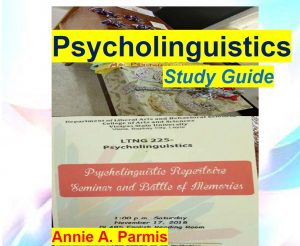Psycholinguistics Study Guide
Annie A. Parmis
- Department of Liberal Arts and Behavioral Sciences (DLABS), VSU, Philippine
- Keywords:
- Psycholinguistics, Neurolinguistics, linguistics, Anthropology
- Abstract:
- Cognitive science is a highly interdisciplinary field of scientific study of the human mind and its structure, processes, and complexities. As it pertains to cognition, it combines the ideas and methods from other disciplines related to intelligence and behavior which include psychology, education, artificial intelligence, anthropology, sociology, neuroscience, computer science, computational linguistics, philosophy, and linguistics in general. Cognitive science basically focuses on how the human mind works with regard to language acquisition, memory, perception, and other forms and contents characterizing the nature of human knowledge beyond preferences and biases. Psycholinguistics is part of the field of cognitive science being a combination of psychology and linguistics
- Altarriba, K., & Moirier, R. (2004/2006). Bilingualism: Language, emotion and mental health in T. Bhalia & W. Ritchie (Eds.) The handbook of bilingualism (pp.250-280). Oxford: Blacwell. Find this resource: Annamalai, E. (2001). Managing multimulingualism in India: Political and linguistic manifestations. New Delhi: SAGE Find this resource: Aram, D.M., Ekelman, B.L., Rose, D.F., Whitaker, H.A.(1985). Verbal and cognitive sequelae following unilateral lesions acquired in early childhood. Journal of Clinical and Experimental Neuropsychology 7(1), 55-78. Archangeli, D., & Langendoen, T. (Eds.) (1997). Optimality theory: An overview. Wiley-Blackwell. Baddeley, A. (1986). Working Memory: New York: Oxford University Press. Baddeley, A.D. (2002). Is working memory still working? European Psychologist, 7, 85-97. Baddeley, A. D., & Hitvh, G. (1974). Working memory. In G. H. Bower (Ed.), The psychology of learning and motivation (Vol. 8, pp. 47-89). New York: Academic Press. Baddeley, A.D., & Gathercole, S., & Papagno, C. (1998). The phonological loop as a language learning device. Psychological Review, 105, 158-173. Baddeley, A.D., & Wilson, B. A., (1985). Phonological coding and short-term memory in patients without speech. Journal of Memory and Language, 24, 490-502.

Published
- January 16, 2021
Categories
Copyright
- Copyright (c) 2021 Annie A. Parmis
License
This work is licensed under a Creative Commons Attribution 4.0 International License.